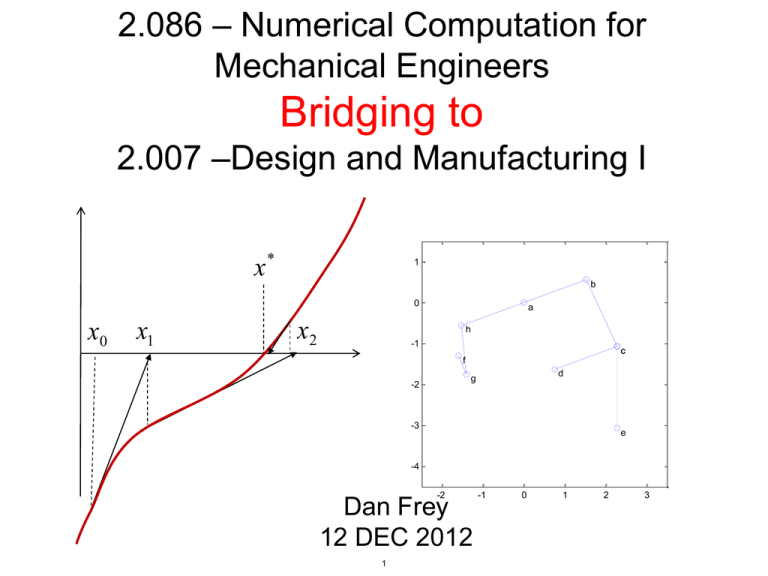
2.086 – Numerical Computation for
Mechanical Engineers
Bridging to
2.007 –Design and Manufacturing I
x*
1
b
0
x0
x1
x2
a
h
-1
c
f
d
g
-2
-3
e
-4
Dan Frey
12 DEC 2012
-2
1
-1
0
1
2
3
2.086 Objectives
• Knowledge
– An understanding of the basic “canon” of
numerical approaches and methods
– sources of error and uncertainty
– An understanding of the basic MATLAB
architecture/environment, data types, syntax
2
2.086 Objectives (cont.)
• Skills
– The ability to formulate an engineering
problem in a mathematical form …
– The ability to test and use (or reject) thirdparty numerical programs with confidence.
– The ability to solve mechanical engineering
problems by numerical approaches …
• Attitudes and Professional Values
– A commitment to always providing … some
indication of error and uncertainty …
3
2.007 Learning Objectives
After taking this subject students should be able to:
• Generate, analyze, and refine the design of electro-mechanical devices
making use of physics and mathematics
• For common machine elements including fasteners, joints, springs,
bearings, gearing, belts, chains, shafts, sensors, and electronics
–
–
–
–
–
•
Describe the function of the element
List common uses in mechanical systems and give examples
Analyze its performance and failure modes
Describe how they are manufactured and the implications of the alternatives
Select an element for a specific use based on information such as that typically
available in a manufacturer’s catalog
Apply experimentation and data analytic principles relevant to mechanical
design
– Consider the effects of geometric variation on a design
– …
•
Communicate a design and its analysis (written, oral, and graphical forms)
– Read and interpret mechanical drawings of systems with moderate complexity
4
– …
Ways to Score
You can multiply your
score by up to 3X by
rotating the Ferris wheel
You earn points
based on how high
you can get the
slug to go on the
“high striker”
You score
one point for
each liter of
inflation your
balloon
You score 1 point per ticket dispensed and removed
5
Operation!
Photo courtesy of watz on Flickr.
6
2.086 Recitation 8
delt = 0.01;
J = 1/delt;
u_exac = (exp(-2*1)+1)/2;
up = 1; %initialization
for i=1:J
un = up + (-2*up+1)*delt;
up = un;
end
7
Apply this to the Macro-Me Robot
• How long would it
take to cross the
2.007 contest field
(8 feet = 2.4m)?
Courtesy of James Penn. Used with permission.
8
A Model of a Motor
E V Rwi
+
9
2.086 Recitation 8 (Adapted)
delt = 0.01;
J = 5/delt;
Kt=0.21; Rm=1;
Vb=4.8; m=1.456; Rw=0.05;
omega(1) = 0; dist(1) = 0; %initialization
for i=2:J
omega(i) = omega(i-1) + (((Kt*Vb/Rm)-((Kt^2)*omega(i-1)/Rm))/(m*(Rw^2)))*delt;
6
dist(i)=dist(i-1)+omega(i-1)*Rw*delt;
end
5
time=delt*min(find(dist>2.4))
4
3
figure(1)
plot(delt*(1:J),dist)
hold on
plot(delt*(1:J),2.4,'r--')
2
1
10
0
0
0.5
1
1.5
2
2.5
3
3.5
4
4.5
5
Newton-Raphson Method
0
Next estimate
Initial guess
11
• Make a guess at
the solution
• Make a linear
approximation of a
function by e.g.,
finite difference
• Solve the linear
system
• Use that solution
as a new guess
• Repeat until some
criterion is met
Example Problem
• Here is a leg from a
simple robot
• If the servo motor
starts from the
position shown and
rotates 45 deg CCW
• How far will the “foot”
descend?
12
Define a Few Functions
R=@(theta) [cos(theta) -sin(theta) 0 0;
sin(theta) cos(theta) 0 0;
0
0
1 0;
0
0
0 1];
T=@(p) [1
0
0
0
0
1
0
0
0 p(1);
0 p(2);
1 p(3);
0 1];
Rp=@(theta,p) T(p)*R(theta)*T(-p);
13
Representing
the Geometry
1
b
0
a
h
-1
c
f
g
d
a=[0 0 0 1]';
b=[1.527 0.556 0 1]';
-3
e
c=[2.277 -1.069 0 1]';
-4
d=[0.75 -1.625 0 1]';
-2
-1
0
1
2
3
e=[2.277 -3.069 0 1]';
f=[-1.6 -1.3 0 1]';
g=[-1.4 -1.75 0 1]';
h=[-1.527 -0.556 0 1]';
leg=[f g h a b c b b+0.05*Rp(-pi/2,b)*(h-b)
h+0.05*Rp(pi/2,h)*(b-h) h b c d c e e+0.1*Rp(-pi/2,e)*(c-e)
c+0.1*Rp(-pi/2,c)*(b-c) b+0.1*Rp(pi/2,b)*(c-b) b];
names=char('f','g','h','a','b','c','d','e');
plot(leg(1,:),leg(2,:),'o-b')
axis equal
axis([-2.5 3.5 -4.5 1.5]);
loc=[1 2 3 4 5 6 13 15];
for i=1:8
text(leg(1,loc(i))+0.1, leg(2,loc(i))-0.1, names(i))
14
end
-2
Animate the Leg Mechanism
instant = 0.0001; % pause between frames
leg=[f g h a b c b b+0.05*Rp(-pi/2,b)*(h-b) h+0.05*Rp(pi/2,h)*(b-h) h b c d c
e e+0.1*Rp(-pi/2,e)*(c-e) c+0.1*Rp(-pi/2,c)*(b-c) b+0.1*Rp(pi/2,b)*(c-b) b];
p = plot(leg(1,:),leg(2,:),'o-b',...
'EraseMode', 'normal');
axis equal
1
axis([-2.5 3.5 -4.5 1.5]);
options = optimset('Display','off');
0
for theta=0:0.5*pi/180:210*pi/180
g2=Rp(theta,f)*g;
-1
link1=@(phi) norm(g-h)-norm(g2-Rp(phi,a)*h);
phi=fzero(link1,0);
-2
h2=Rp(phi,a)*h;
b2=Rp(phi,a)*b;
-3
link2=@(gamma) norm(b-c)-norm(b2-Rp(gamma,d)*c);
-4
gamma=fzero(link2,0);
c2=Rp(gamma,d)*c;
-2
-1
0
1
2
3
link3=@(beta) norm(c2-Rp(beta,b2)*T(b2-b)*c);
beta=fsolve(link3,0,options);
e2=Rp(beta,b2)*T(b2-b)*e;
leg=[f g2 h2 a b2 c2 b2 b2+0.05*Rp(-pi/2,b2)*(h2-b2) h2+0.05*Rp(pi/2,h2)*(b2h2) h2 b2 c2 d c2 e2 e2+0.1*Rp(-pi/2,e2)*(c2-e2) c2+0.1*Rp(-pi/2,c2)*(b2-c2)
b2+0.1*Rp(pi/2,b2)*(c2-b2) b2];
set(p,'XData',leg(1,:), 'YData',leg(2,:))
pause(instant)
15
end
f
q
g
b
Back-Drive the Leg with Link cd
instant = 0.0001; % pause between frames
leg=[f g h a b c b b+0.05*Rp(-pi/2,b)*(h-b) h+0.05*Rp(pi/2,h)*(b-h) h b c d c
e e+0.1*Rp(-pi/2,e)*(c-e) c+0.1*Rp(-pi/2,c)*(b-c) b+0.1*Rp(pi/2,b)*(c-b) b];
p = plot(leg(1,:),leg(2,:),'o-b',...
1
'EraseMode', 'normal');
axis equal
0
axis([-2.5 3.5 -4.5 1.5]);
for gamma=0:-0.5*pi/180:-50*pi/180
c2=Rp(gamma,d)*c;
-1
link1=@(phi) norm(b-c)-norm(Rp(phi,a)*b-c2);
phi=fzero(link1,0);
-2
b2=Rp(phi,a)*b;
h2=Rp(phi,a)*h;
link2=@(theta) norm(g-h)-norm(Rp(theta,f)*g-h2);
-3
theta=fzero(link2,0);
g2=Rp(theta,f)*g; leg=[f g2 h2 a b2 c2 d c2 e2];
-4
link3=@(beta) norm(c2-Rp(beta,b2)*T(b2-b)*c);
beta=fsolve(link3,0,options);
-2
-1
0
1
2
e2=Rp(beta,b2)*T(b2-b)*e;
leg=[f g2 h2 a b2 c2 b2 b2+0.05*Rp(-pi/2,b2)*(h2-b2) h2+0.05*Rp(pi/2,h2)*(b2h2) h2 b2 c2 d c2 e2 e2+0.1*Rp(-pi/2,e2)*(c2-e2) c2+0.1*Rp(-pi/2,c2)*(b2-c2)
b2+0.1*Rp(pi/2,b2)*(c2-b2) b2];
set(p,'XData',leg(1,:), 'YData',leg(2,:))
pause(instant)
end
16
f
b
q
g
3
A Proper Pour
Image © Peter Ridley. All rights reserved. This content is excluded from our Creative
Commons license. For more information, see http://ocw.mit.edu/fairuse.
Source: Ridley, P. “Teaching Mechanism Design.” Proceedings of the 2006 Australasian
Conference on Robotics & Automation, December 6 - 8, Auckland, New Zealand.
17
3 Position Synthesis
• Say we want a
mechanism to
guide a body in a
prescribed way
• Pick 3 positions
• Pick two
attachment points
• The 4 bar
mechanism can
be constructed
graphically
18
Import the Desired Motions into Matlab
% dxf2coord 1.1 matrix
% author: lukas wischounig, innsbruck, austria (dept. of geology,
% university innsbruck), email: csad0018@uibk.ac.at
% date: may 2005
% filename: dxf2coord_11_matrix.m
figure(1)
hold on
axis equal
x=2;y=3;
for i=1:7
plot(polylines(find(polylines(:,1)==i),x),polylines(find(polylines(:,1)==i),y))
end
plot(points(:,x)+0.2,points(:,y)-0.2,'ro')
names=char('1a', '2a', '3a','3c', '2b', '1b');
for i=1:6
text(points(i,x), points(i,y), names(i,:))
end
19
Use a Function Minimizer to Make the
Mechanism More Compact
x_link=-6;
sum_sqr_err=@(input) sum([(input(2)-norm([x_link input(1)]-points(1,x:y)))^2 ...
(input(2)-norm([x_link input(1)]-points(3,x:y)))^2 ...
(input(2)-norm([x_link input(1)]-points(3,x:y)))^2]);
best=fminsearch(sum_sqr_err,[-1 4]);
bext_y=best(1);
best_rad=best(2);
Force the joint to lie along this line
Find the
y location and radius
of a circle that fits the
commanded points
1a 2a 3a in a least
squares sense.
20
Automating the Task
• Very simple mechanically
• Nicely compact
• Springs could allow the servo to be loaded
uniformly on the up and down stroke
Image © Peter Ridley. All rights reserved. This content is excluded from our Creative
Commons license. For more information, see http://ocw.mit.edu/fairuse.
Source: Ridley, P. “Teaching Mechanism Design.” Proceedings of the 2006 Australasian
Conference on Robotics & Automation, December 6 - 8, Auckland, New Zealand.
21
A Video on 3 Pos’n Synthesis
http://blossoms.mit.edu/video/frey.html
22
What about 3D Mechanisms?
I the past, we didn’t
emphasize
3D mechanisms in the
subject 2.007
But thanks to 2.086,
now maybe we can!
© source unknown. All rights reserved. This content
is excluded from our Creative Commons license. For
more information, see http://ocw.mit.edu/fairuse.
Rear suspension of a Honda Accord
23
An Idea for a 2.007
“Medical” Scoring Challenge
• Angioplasty -- mechanically widening
narrowed or obstructed arteries (to correct
effects of atherosclerosis)
• A balloon on a guide wire
is placed and then inflated
• The balloon crushes the
fatty deposits
• A stent may be used so the
vessel remains open
24
© source unknown. All rights reserved. This content
is excluded from our Creative Commons license. For
more information, see http://ocw.mit.edu/fairuse.
What I Want to Design
• Scaled up stent
• Starts narrow and can be expanded with
moderate pressure
• Kinematic freedom similar to actual stent
• Relatively thin in radial direction
• Stays open after expansion
• Can be reused many times
• Teach about 3D
mechanism design
25
© source unknown. All rights reserved. This content
is excluded from our Creative Commons license. For
more information, see http://ocw.mit.edu/fairuse.
First Cut at the 3D Mechanism
26
© source unknown. All rights reserved. This content
is excluded from our Creative Commons license. For
more information, see http://ocw.mit.edu/fairuse.
Using fsolve to Animate the Stent
• Can I import the 3D CAD into Matlab?
• Can I control the motions of the objects?
27
Questions?
28
MIT OpenCourseWare
http://ocw.mit.edu
2.086 Numerical Computation for Mechanical Engineers
Fall 2012
For information about citing these materials or our Terms of Use, visit: http://ocw.mit.edu/terms.


